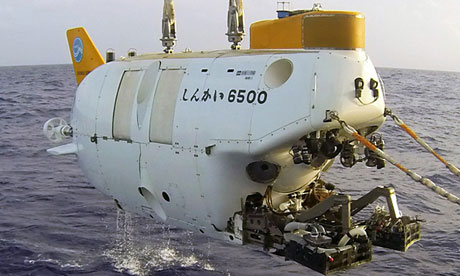Five kilometres, or 3.1 miles, is not a great distance on land – the length of a pleasant stroll. But five kilometres vertically in the ocean separates different worlds. On 21 June I had the opportunity to make that short journey to another world, by joining Japanese colleagues for the first manned mission to the deepest known hydrothermal vents, five thousand metres down on the ocean floor.
The goal of the expedition, led by Prof Ken Takai of the Japan Agency for Marine-Earth Science and Technology, was to study the limits of life at deep-sea vents in the Cayman Trough as part of a round-the-world voyage of discovery by the research ship RV Yokosuka. In February, I had led a British expedition investigating the same vents with a remotely operated vehicle, so I was delighted to join the team actually visiting them inside one of the few machines that can carry people beyond five kilometres deep.
Crammed into the two-metre chamber of the Shinkai6500 with pilot Yoshitaka Sasaki and co-pilot Yudai Tayama, we waited for the team on the deck of the RV Yokosuka to hook us up to the stern gantry and lift us out over the rolling blue waters of the Caribbean. We fanned ourselves as the temperature inside our hollow metal ball rose past 30C in the tropical morning sun. At 09.07 we were lowered gently into the water, detached from the ship, and sank beneath the grip of the waves on our journey into the void below.
Five minutes after leaving the surface, we passed 200 metres depth and entered the "twilight zone", where sunlight is already too dim for microscopic algae to thrive. Our portholes became discs of the deepest blue imaginable – a colour eloquently described as "luminous black" by deep-sea pioneer William Beebe, after whom we named the undersea vents below. Beebe and his colleague Otis Barton were the first people to venture into the deep ocean and see its life first-hand, when they dived in their bathysphere in the early 1930s.
At 09.29 we passed 923 metres deep – the maximum depth reached by Beebe and Barton in 1934. Moments later we entered the "midnight zone" beyond 1,000 metres deep, where not even the faintest traces of sunlight remain. With our sub spinning slowly during descent, and an outside water temperature of 5.3C now thankfully cooling us, we were passing through one of the least-known realms of our planet: the huge interior volume of the ocean.
This is a water world without walls, inhabited by creatures of ethereal beauty. From the vantage point of my 10-centimetre porthole, I glimpsed life forms with outlines like blown glass occasionally drifting past our lights, while small crustaceans hovered around like flies, keeping pace with our descent. All are part of the ecology that transfers carbon from surface waters to the depths below, via the perpetual rain of particles processed by those that live here.
At 09.56 we reached 2,200 metres depth – a personal milestone, as that was the deepest I had been before, but this time not even halfway to the bottom. Forty minutes later we passed the average depth of the oceans, at around 3,800 metres. Finally, after free-falling through the water for two hours, we approached the seafloor at a depth of 5,099 metres, stirring up a temporary cloud of silt as we touched down.
As the silt cleared, we found ourselves on a flat plain of yellow-tinged mud, inscribed with pits, burrows and tracks by species that eke out their existence on the detritus that settles from above. To reach the Beebe Vent Field some 400 metres away, we crept across a landscape of alien contours, shaped by processes different from those that sculpt the land.

Within a few minutes, the pool of light in front of our submersible revealed a slope of grey lava rubble, which eventually gave way to jumbled blocks of rust-coloured sulfides – the minerals formed by the deep-sea vents. Soon afterwards, we arrived at our target site: a set of "black-smoker chimneys" at a depth of 4,967 metres.
These slender mineral spires, two storeys high, are pipes from which fluids hotter than 400C gush into the ocean. The hot fluids are quenched by the chilly waters of the deep sea, and form a billowing plume of smoke-like particles that we can detect nearly a kilometre above. Sitting next to this force of nature in the Shinkai6500, surrounded by vast darkness and a pressure greater than half a tonne per square centimetre, was simultaneously humbling and wonderful.
Through dexterous operation of the Shinkai6500's mechanical arms by pilot Sasaki-san, we quickly began collecting samples of rocks, the hot fluids from the vents, and the creatures thriving around them: speckled anemones with almost-translucent tentacles, and the orange-tinted shrimp scurrying among them... read more:






0 comments:
Post a Comment